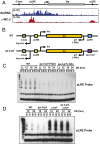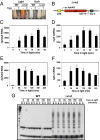The frequency natural antisense transcript first promotes, then represses, frequency gene expression via facultative heterochromatin
- PMID: 25831497
- PMCID: PMC4394252
- DOI: 10.1073/pnas.1406130112
The frequency natural antisense transcript first promotes, then represses, frequency gene expression via facultative heterochromatin
Abstract
The circadian clock is controlled by a network of interconnected feedback loops that require histone modifications and chromatin remodeling. Long noncoding natural antisense transcripts (NATs) originate from Period in mammals and frequency (frq) in Neurospora. To understand the role of NATs in the clock, we put the frq antisense transcript qrf (frq spelled backwards) under the control of an inducible promoter. Replacing the endogenous qrf promoter altered heterochromatin formation and DNA methylation at frq. In addition, constitutive, low-level induction of qrf caused a dramatic effect on the endogenous rhythm and elevated circadian output. Surprisingly, even though qrf is needed for heterochromatic silencing, induction of qrf initially promoted frq gene expression by creating a more permissible local chromatin environment. The observation that antisense expression can initially promote sense gene expression before silencing via heterochromatin formation at convergent loci is also found when a NAT to hygromycin resistance gene is driven off the endogenous vivid (vvd) promoter in the Δvvd strain. Facultative heterochromatin silencing at frq functions in a parallel pathway to previously characterized VVD-dependent silencing and is needed to establish the appropriate circadian phase. Thus, repression via dicer-independent siRNA-mediated facultative heterochromatin is largely independent of, and occurs alongside, other feedback processes.
Keywords: DNA methylation; circadian rhythm; heterochromatin; natural antisense transcripts.
Conflict of interest statement
The authors declare no conflict of interest.
Figures








References
-
- Heintzen C, Liu Y. The Neurospora crassa circadian clock. Adv Genet. 2007;58:25–66. - PubMed
-
- Brunner M, Káldi K. Interlocked feedback loops of the circadian clock of Neurospora crassa. Mol Microbiol. 2008;68(2):255–262. - PubMed
-
- Crosthwaite SK, Dunlap JC, Loros JJ. Neurospora wc-1 and wc-2: Transcription, photoresponses, and the origins of circadian rhythmicity. Science. 1997;276(5313):763–769. - PubMed
Publication types
MeSH terms
Substances
Grants and funding
LinkOut - more resources
Full Text Sources
Other Literature Sources

